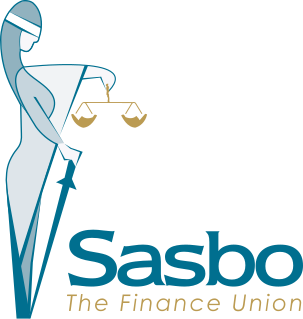Related Research Articles

SASBO – The Finance Union is a trade union in South Africa. It was founded in 1916 and has a membership of 70,000.

The Federation of South African Trade Unions (FOSATU) was a trade union federation in South Africa.
The South African Trades Union Congress (TUC) was a national trade union federation in South Africa.
The South African Railways and Harbours Union was formed by black workers of the South African Railways and Harbours Administration after they had been expelled from the National Union of Railway and Harbour Servants.
The South African Congress of Trade Unions (SACTU) was a national trade union federation in South Africa.
The Food and Canning Workers' Union (FCWU) was a trade union representing food processing workers in South Africa. Its members were mainly based in the Western and Eastern Cape. It was affiliate with the African Food and Canning Workers' Union (AFCWU).
The Trade Union Council of South Africa (TUCSA) was national trade union federation in South Africa.
The South African Boilermakers', Iron and Steel Workers', Shipbuilders' and Welders' Society (SABS) was a trade union representing metalworkers and shipbuilders in South Africa.
The General Workers' Union (GWU) was a general union representing workers in South Africa.

The Chemical Workers' Industrial Union (CWIU) was a trade union representing workers in chemical and related industries in South Africa.
The South African Trades and Labour Council (SAT&LC) was a national trade union federation in South Africa.
The South African Federation of Trade Unions (SAFTU) was a national trade union federation of workers representing workers in South Africa.
The South African Footplate Staff Association (SAFSA) was a trade union representing white railway workers in South Africa.
Henry William Sampson, often known as "Sammy", was an English-born South African trade unionist and politician.
The Cape Federation of Labour Unions (CFLU) was a trade union federation in South Africa.
James Dominic Francis Briggs was an Australian-born South African politician and trade unionist.
The Amalgamated Union of Building Trade Workers of South Africa (AUBTWSA) is a trade union representing workers in the construction industry in South Africa.
The Amalgamated Society of Woodworkers of South Africa (ASW) was a trade union representing carpenters, joiners and those in related trades in South Africa.
The Sweet Workers' Union (SWU) was a small but long-lived union representing confectionery workers in South Africa.
The South African Equity Workers' Association (SAEWA) is a general union in South Africa.
References
- 1 2 Visser, Wessel P. (December 2004). ""To Fight the Battles of the Workers": The Emergence of Pro-strike Publications in Early Twentieth-Century South Africa". International Review of Social History. 49 (3): 401–434. doi: 10.1017/S0020859004001737 . S2CID 145095586.
- ↑ Du Toit, Martin André (1976). South African Trade Unions: History, Legislation, Policy. McGraw-Hill. ISBN 9780070913110.
- ↑ Ticktin, D. (1973). The Origins of the South African Labour Party 1888-1910 (PDF). Vol. 2. Cape Town: University of Cape Town. Retrieved 8 March 2021.
- ↑ Gitsham, Ernest; Trembath, James H. (1926). A first account of labour organisation in South Africa (PDF). Durban: E. P. & Commercial Printing. Retrieved 11 April 2021.
- ↑ Simons, Harold; Simons, Ray (1987). One Hundred Years of Job Reservation on the South African Mines. International Labour Office. ISBN 9789221061588.
- 1 2 Miller, Shirley (1982). Trade Unions in South Africa 1970-1980: a directory and statistics. Cape Town: Southern Africa Labour and Development Research Unit. ISBN 0799204692.
- ↑ Jubber, Ken (1979). South Africa Industrial Relations and Industrial Sociology. Juta. ISBN 9780702110085.
- ↑ "Affiliated trade unions". FEDUSA. Retrieved 8 March 2021.